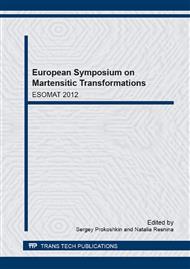[1]
M.A. Polinsky, D.W. Norwich, M.H. Wu, A study of the effects of surface modifications and processing on the fatigue properties of NiTi wire, Proc. Int. Conf. on 'SMST. (2000) 1-18.
Google Scholar
[2]
M.M. Patel, R.F. Gordon, An Investigation of Diverse Surface Finishes on Fatigue Properties of Superelastic Nitinol Wire, Proc. Int. Conf. on 'SMST. (2006) 61-71.
Google Scholar
[3]
W. Miao, X. Mi, X. Wang, H. Li, B. Qi, Effect of different surface treatments on fatigue life of NiTi wires, Materials Science Forum. Vol. 561-5, (2007) 2265-68.
DOI: 10.4028/www.scientific.net/msf.561-565.2265
Google Scholar
[4]
K. Gall, H.J. Maier, Cyclic deformation mechanisms in precipitated NiTi shape memory alloys, Acta Materialia 50 (2002) 4643-4657.
DOI: 10.1016/s1359-6454(02)00315-4
Google Scholar
[5]
M. Wessels, E. Hekman, B. Verkerke, Influence of prestrain, heat treatment and surface treatment on bending fatigue of NiTi rods, Journal of Biomechanics S1 (2012) 45.
DOI: 10.1016/s0021-9290(12)70055-6
Google Scholar
[6]
M. Wagner, S. Dey, H. Gugel, G. Frenzel, C. Somsen, G. Eggeler, Effect of low-temperature precipitation on the transformation characteristics of Ni-rich NiTi shape memory alloys during thermal cycling, Intermetallics. Vol. 18 (2010) 1172-1179.
DOI: 10.1016/j.intermet.2010.02.048
Google Scholar
[7]
Melton, K.N. & Mercier, O. Fatigue of NiTi Thermoelastic Martinsites. Acta Metallurgica. Vol. 27, (1979) 137-144.
DOI: 10.1016/0001-6160(79)90065-8
Google Scholar
[8]
A. Heckmann, E. Hornbogen, Effects of thermomechanical pre-treatment on pseudo-elastic fatigue of a NiTi alloy, Materials Science Forum. Mat. Science Forum. Vol. 394-5 (2002) 325-328.
DOI: 10.4028/www.scientific.net/msf.394-395.325
Google Scholar
[9]
M. Yu. Kollerov, D. Gusev, Application of nitinol fixings for the osteosyntesis of sternum at the cardio- and thoracic surgeries. Proc. of the Int. Con. «Ti-2008 in CIS» (2008) 407.
Google Scholar
[10]
M. Reinoehl, D. Bradley, R. Bouthot, J. Proft, The influence of melt practice on final fatigue properties of superelastic NiTi wires, Proc. Int. Conf. on SMST,. (2000) 397–403.
Google Scholar
[11]
M. M. Patel, D. L. Plumley, R. J. Bouthot, The significance of melt practice on fatigue properties of superelastic NiTi fine diameter wire, Proc. Int. Conf. on SMST,. (2006) 43-52.
Google Scholar
[12]
N. Morgan, A. Wick, J. DiCello, R. Graham, Carbon and oxygen levels in nitinol alloys and the implications for medical device manufacture and durability, Proc. Int. Conf. on SMST,. (2006) 821–828.
Google Scholar
[13]
V.G. Chuprina, I.M. Shalya, Reactions of TiNi with Oxygen, Powder Metall. Met. Ceram. 41 (2002) 85–89.
Google Scholar
[14]
A. Coda, S. Zilio, D. Norwich, F. Sczerzenie, Characterization of Inclusions in VIM/VAR NiTi Alloys, Journal of Materials Engineering and Performance. 21(2012) 2572-2577.
DOI: 10.1007/s11665-012-0366-1
Google Scholar


